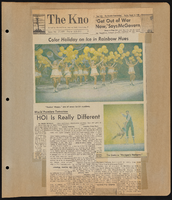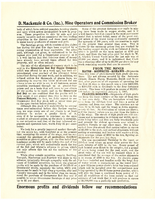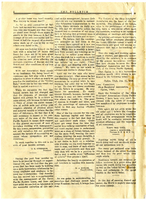Search the Special Collections and Archives Portal
Search Results
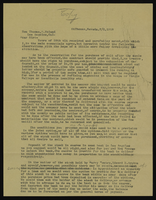
Correspondence, Levi Syphus to Thomas Toland
Date
1917-05-06
Archival Collection
Description
This folder is from the "Correspondence" file of the Sadie and Hampton George Papers (MS-00434)
Text
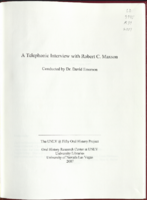
Transcript of interview with Robert C. Maxson by Dr. David Emerson, May 15, 2007
Date
2007-05-15
Archival Collection
Description
Dr. Robert C. Maxson was president of UNLV for ten years, 1984 to 1994. When he arrived, discussions were already under way about developing an engineering school. Certain elements in the community, such as Summa Corporation, were lobbying for such a program here in southern Nevada. Dr. Maxson began receiving printed materials and phone calls about it, and he started putting his fund raising skills to good use. He believes that civic pride in the young university, as well as a sense that an engineering school would be good for business, led many individuals, hotels, and corporations to open their pocketbooks. Locally, Dr. Maxson found generous support from Tom Beam, Nevada Power, the Summa Corporation, and many other businesses and individuals. Since the legislature only meets every two years in northern Nevada, Robert and others made many trips to Carson City that first year to discuss every nuance of the project. He spent considerable time with Senator Bill Raggio, John Marvel, Bill Bilyeu, and other legislators convincing them that Nevada would get its money's worth. He also gives major credit to Las Vegas civic leaders for their influence and the fact that they had rallied behind this cause. Once the funding was approved, Dr. Maxson insisted on and facilitated the accreditation of the program. Faculty members enthusiastically got behind this push and accreditation was achieved in a remarkably short time. The next order of business was funding an honors program for deserving students. Dr. Len Zane was given this project and began recruiting students. Individuals in the private sector were invited to fund academic scholarships, and they responded generously. Dr. Maxson traveled the state attending high school commencements and recruited valedictorians on the strength of offering those students the honors scholarships. Dr. Maxson greatly enjoyed his time as president at UNLV. He feels he was privileged to be part of its growth and expansion, to have worked with enthusiastic, energetic faculty, and to have encouraged the community's desire to get behind the growth of the university.
Text
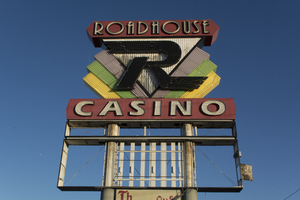
Photographs of Roadhouse Casino sign, Las Vegas (Nev.), March 14, 2017
Date
2017-03-14
2017-09-01
Archival Collection
Description
The Roadhouse Casino sign sits unlit at 2100 North Boulder Highway. Information about the sign is available in the Southern Nevada Neon Survey Data Sheet.
Site address: 2100 N Boulder Hwy
Sign owner: Robert McMackin
Sign details: Roadhouse approved for gaming 1988, Robert McMackin bought the Roadhouse 1992, but it closed 2002. They planned to refurbish and reopen by 2010 but has been in legal trouble and has not reopened.
Sign condition: 2- reader board portion/plastic back lit portion is gone and paint has faded drastically
Sign form: Pylon
Sign-specific description: Big Letters on top "Roadhouse" below Is a Huge Letter "R". Still up but in horrible condition. Reader board is a frame and appears to be scrapped. No upkeep has been made to the sign. There is an array of colors behind the 'R' such as purple, white, yellow and green in a parallel plume shape.
Sign - type of display: Neon
Sign - media: Steel
Sign - non-neon treatments: There must have been plastic on this sign since there is a sign box that would contain it.
Sign environment: This location is on Boulder Hwy. near Sunset Road.
Sign - thematic influences: The letter R in the middle of the sign is remnant of the 1980's car/video game font.
Survey - research locations: Las Vegas Sun Article synopsis https://vegasinc.lasvegassun.com/business/legal/2012/mar/26/city-henderson-reverses-course-roadhouse-casino-li/ Review Journal article https://www.reviewjournal.com/business/casinos-gaming/station-casinos-henderson-settle-roadhouse-dispute/
Survey - research notes: The articles were helpful with finding information on this property since other avenues did not have any information on it.
Surveyor: Wyatt Currie-Diamond
Survey - date completed: 2017-09-01
Sign keywords: Pylon; Neon; Steel; Plastic; Incandescent; Backlit; Back to back
Site address: 2100 N Boulder Hwy
Sign owner: Robert McMackin
Sign details: Roadhouse approved for gaming 1988, Robert McMackin bought the Roadhouse 1992, but it closed 2002. They planned to refurbish and reopen by 2010 but has been in legal trouble and has not reopened.
Sign condition: 2- reader board portion/plastic back lit portion is gone and paint has faded drastically
Sign form: Pylon
Sign-specific description: Big Letters on top "Roadhouse" below Is a Huge Letter "R". Still up but in horrible condition. Reader board is a frame and appears to be scrapped. No upkeep has been made to the sign. There is an array of colors behind the 'R' such as purple, white, yellow and green in a parallel plume shape.
Sign - type of display: Neon
Sign - media: Steel
Sign - non-neon treatments: There must have been plastic on this sign since there is a sign box that would contain it.
Sign environment: This location is on Boulder Hwy. near Sunset Road.
Sign - thematic influences: The letter R in the middle of the sign is remnant of the 1980's car/video game font.
Survey - research locations: Las Vegas Sun Article synopsis https://vegasinc.lasvegassun.com/business/legal/2012/mar/26/city-henderson-reverses-course-roadhouse-casino-li/ Review Journal article https://www.reviewjournal.com/business/casinos-gaming/station-casinos-henderson-settle-roadhouse-dispute/
Survey - research notes: The articles were helpful with finding information on this property since other avenues did not have any information on it.
Surveyor: Wyatt Currie-Diamond
Survey - date completed: 2017-09-01
Sign keywords: Pylon; Neon; Steel; Plastic; Incandescent; Backlit; Back to back
Mixed Content
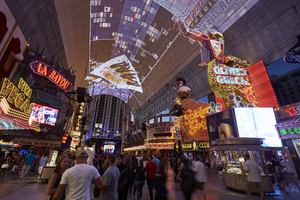
Photographs of La Bayou Casino, Las Vegas (Nev.), June 24, 2016
Date
2016-06-24 to 2017-09-08
Archival Collection
Description
The permanently closed Labayou Casino sits at 15 Fremont Street at the Fremont Street Experience. Information about the sign is available in the Southern Nevada Neon Survery Data Sheet.
Site address: 15 Fremont St
Sign owner: Derek Stevens
Sign details: Opened 1920 as Northern Club By Mayme Stocker. 1943-1960 operated as a few different businesses. 1970 opened as The Coin Castle, 1999 was renovated and opened as La Bayou, 2016 bought by Derek Stevens and torn down.
Sign condition: No longer there
Sign form: Architectural sign
Sign-specific description: Three neon signs site on top of a shack made of wood and sheet metal that is meant to represent something that might be seen in Louisiana. Two windows with green shutters are "open" with T.V. screens inside. Two neon signs sit at the top of the shack that spell out La Bayou in red neon and the cabinet is trimmed with purple neon. At the front of the property, above the entry, is a red neon sign that says "26 New Orleans Daiquiris."
Sign - type of display: Neon and incandescent
Sign - media: Steel, fiberglass
Sign environment: Part of the Fremont Street Experience, next to Golden Gate Casino
Sign - date of installation: c. 1999
Sign - thematic influences: The property has a theme element, which was popular of casinos of Las Vegas in the 1990s.
Sign - artistic significance: Property was decorated with a Louisiana inspired bayou, swamp motif.
Survey - research locations: Newspapers
Survey - research notes: https://www.reviewjournal.com/business/casinos-gaming/mermaids-la-bayou-and-glitter-gulch-come-to-a-close-on-fremont-photos/ https://lasvegassun.com/news/2016/jun/25/patrons-say-farewell-to-mermaids-and-la-bayou-in-d/ http://classiclasvegas.squarespace.com/downtown-history/?currentPage=3
Survey - other remarks: Property was razed 2016
Surveyor: Wyatt Currie-Diamond
Survey - date completed: 2017-09-08
Sign keywords: Architectural; Neon; Incandescent; Steel; Fiberglass
Site address: 15 Fremont St
Sign owner: Derek Stevens
Sign details: Opened 1920 as Northern Club By Mayme Stocker. 1943-1960 operated as a few different businesses. 1970 opened as The Coin Castle, 1999 was renovated and opened as La Bayou, 2016 bought by Derek Stevens and torn down.
Sign condition: No longer there
Sign form: Architectural sign
Sign-specific description: Three neon signs site on top of a shack made of wood and sheet metal that is meant to represent something that might be seen in Louisiana. Two windows with green shutters are "open" with T.V. screens inside. Two neon signs sit at the top of the shack that spell out La Bayou in red neon and the cabinet is trimmed with purple neon. At the front of the property, above the entry, is a red neon sign that says "26 New Orleans Daiquiris."
Sign - type of display: Neon and incandescent
Sign - media: Steel, fiberglass
Sign environment: Part of the Fremont Street Experience, next to Golden Gate Casino
Sign - date of installation: c. 1999
Sign - thematic influences: The property has a theme element, which was popular of casinos of Las Vegas in the 1990s.
Sign - artistic significance: Property was decorated with a Louisiana inspired bayou, swamp motif.
Survey - research locations: Newspapers
Survey - research notes: https://www.reviewjournal.com/business/casinos-gaming/mermaids-la-bayou-and-glitter-gulch-come-to-a-close-on-fremont-photos/ https://lasvegassun.com/news/2016/jun/25/patrons-say-farewell-to-mermaids-and-la-bayou-in-d/ http://classiclasvegas.squarespace.com/downtown-history/?currentPage=3
Survey - other remarks: Property was razed 2016
Surveyor: Wyatt Currie-Diamond
Survey - date completed: 2017-09-08
Sign keywords: Architectural; Neon; Incandescent; Steel; Fiberglass
Mixed Content
Pagination
Refine my results
Content Type
Creator or Contributor
Subject
Archival Collection
Digital Project
Resource Type
Year
Material Type
Place
Language
Records Classification

